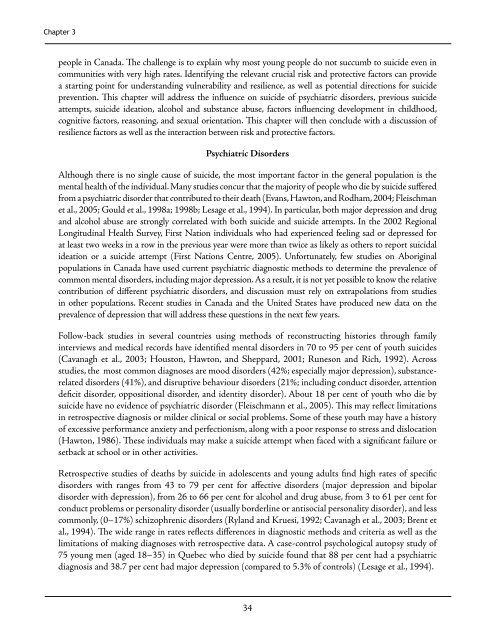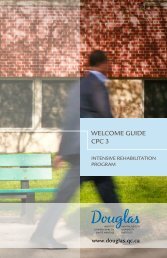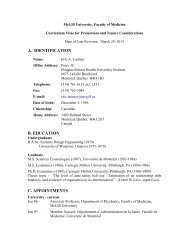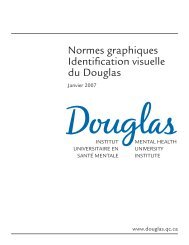Chapter 3Orig<strong>in</strong>s of <strong>Suicide</strong>: Individual Vulnerability and ResilienceJust hav<strong>in</strong>g discussions and educat<strong>in</strong>g people on what to do if you have a friend [who issuicidal], that’s a really good idea. Maybe even try<strong>in</strong>g to tackle the problem, like, whatcauses people to be suicidal? I don’t know how viable that is, but just like, try<strong>in</strong>g to stopth<strong>in</strong>gs like, boredom. Like, hav<strong>in</strong>g a centre where people can go to <strong>in</strong>stead of just be<strong>in</strong>gbored and turn<strong>in</strong>g to drugs and becom<strong>in</strong>g suicidal or try<strong>in</strong>g to stop abuse and stuff likethat. It could be one way to try to stop suicide (First Nation youth).<strong>Suicide</strong> is the outcome of multiple forces at work with<strong>in</strong> the person, as well as <strong>in</strong> their <strong>in</strong>teractionswith others <strong>in</strong> the family, community, and wider social spheres. Some acts of suicide are deliberate andplanned, others are sudden and impulsive. Most occur <strong>in</strong> the context of <strong>in</strong>tense emotional pa<strong>in</strong> andmisery, but this may be the result of long-stand<strong>in</strong>g <strong>in</strong>tolerable life circumstances, a briefer period ofsevere depression, or a crisis of anger, agitation, and despair aggravated by <strong>in</strong>toxication. Even <strong>in</strong> suchsudden crises, however, a wide range of <strong>in</strong>fluences and experiences over the person’s whole lifespan maycontribute to the suicidal act.Factors that <strong>in</strong>crease the likelihood an <strong>in</strong>dividual will commit suicide are termed risk factors; while thosefactors that decrease risk or make the <strong>in</strong>dividual more resilient are termed protective factors. Risk andprotective factors may be thought of <strong>in</strong> terms of the tim<strong>in</strong>g of their impact on suicide: predispos<strong>in</strong>g factors(e.g. major depression, family violence) <strong>in</strong>crease the person’s vulnerability to commit suicide; contribut<strong>in</strong>gfactors (e.g. impulsivity, lack of social supports) amplify the risk <strong>in</strong> already vulnerable <strong>in</strong>dividuals;precipitat<strong>in</strong>g factors (e.g. loss of a close relationship, rejection, gett<strong>in</strong>g <strong>in</strong>to trouble with the law) are theimmediate triggers or provocation for the suicidal act; and enabl<strong>in</strong>g factors (e.g. availability of firearms,<strong>in</strong>toxication) make it possible for the person to commit suicide.The Royal Commission on <strong>Aborig<strong>in</strong>al</strong> <strong>People</strong>s (1995) organized their discussion of risk factors commonlyassociated with suicide <strong>in</strong>to four broad groups: psychobiological, situational, socio-economic, andcultural. This chapter focuses on psychobiological and situational factors that affect <strong>in</strong>dividuals. Chapter4 will discuss broader social, economic, political, and cultural factors. It is important to emphasize thatthis division is only for convenience. <strong>Suicide</strong>, like any human experience, emerges from a dense web of<strong>in</strong>teractions of biological, psychological, social, and cultural processes. These factors <strong>in</strong>fluence the personfrom <strong>in</strong>fancy onward, <strong>in</strong>creas<strong>in</strong>g resilience or mak<strong>in</strong>g <strong>in</strong>dividuals more vulnerable to the effects of stress,conflict, violence, and loss. Social, economic, cultural, and political factors also may create predicamentsthat drive vulnerable <strong>in</strong>dividuals to suicidal behaviour.Because suicide is ultimately an <strong>in</strong>dividual act and because the discipl<strong>in</strong>es of psychiatry and psychologyhave tended to th<strong>in</strong>k <strong>in</strong> terms of <strong>in</strong>dividual function<strong>in</strong>g, most research on suicide has focused ondeterm<strong>in</strong>ants at the <strong>in</strong>dividual level. Often, this work is framed <strong>in</strong> terms of risk and protective factorsthat <strong>in</strong>crease or decrease the likelihood of suicidal behaviour <strong>in</strong> a population or group of <strong>in</strong>dividuals.Risk factors are associated with vulnerability, while protective factors contribute to resilience.Research on suicide <strong>in</strong> other populations may contribute much to our understand<strong>in</strong>g of the problemamong <strong>Aborig<strong>in</strong>al</strong> people. This section, therefore, reviews work on risk and protective factors <strong>in</strong> the generalpopulation that is relevant to <strong>Aborig<strong>in</strong>al</strong> people, along with those few studies that directly address <strong>Aborig<strong>in</strong>al</strong>33
Chapter 3people <strong>in</strong> <strong>Canada</strong>. The challenge is to expla<strong>in</strong> why most young people do not succumb to suicide even <strong>in</strong>communities with very high rates. Identify<strong>in</strong>g the relevant crucial risk and protective factors can providea start<strong>in</strong>g po<strong>in</strong>t for understand<strong>in</strong>g vulnerability and resilience, as well as potential directions for suicideprevention. This chapter will address the <strong>in</strong>fluence on suicide of psychiatric disorders, previous suicideattempts, suicide ideation, alcohol and substance abuse, factors <strong>in</strong>fluenc<strong>in</strong>g development <strong>in</strong> childhood,cognitive factors, reason<strong>in</strong>g, and sexual orientation. This chapter will then conclude with a discussion ofresilience factors as well as the <strong>in</strong>teraction between risk and protective factors.Psychiatric DisordersAlthough there is no s<strong>in</strong>gle cause of suicide, the most important factor <strong>in</strong> the general population is themental health of the <strong>in</strong>dividual. Many studies concur that the majority of people who die by suicide sufferedfrom a psychiatric disorder that contributed to their death (Evans, Hawton, and Rodham, 2004; Fleischmanet al., 2005; Gould et al., 1998a; 1998b; Lesage et al., 1994). In particular, both major depression and drugand alcohol abuse are strongly correlated with both suicide and suicide attempts. In the 2002 RegionalLongitud<strong>in</strong>al Health Survey, First Nation <strong>in</strong>dividuals who had experienced feel<strong>in</strong>g sad or depressed forat least two weeks <strong>in</strong> a row <strong>in</strong> the previous year were more than twice as likely as others to report suicidalideation or a suicide attempt (First Nations Centre, 2005). Unfortunately, few studies on <strong>Aborig<strong>in</strong>al</strong>populations <strong>in</strong> <strong>Canada</strong> have used current psychiatric diagnostic methods to determ<strong>in</strong>e the prevalence ofcommon mental disorders, <strong>in</strong>clud<strong>in</strong>g major depression. As a result, it is not yet possible to know the relativecontribution of different psychiatric disorders, and discussion must rely on extrapolations from studies<strong>in</strong> other populations. Recent studies <strong>in</strong> <strong>Canada</strong> and the United States have produced new data on theprevalence of depression that will address these questions <strong>in</strong> the next few years.Follow-back studies <strong>in</strong> several countries us<strong>in</strong>g methods of reconstruct<strong>in</strong>g histories through family<strong>in</strong>terviews and medical records have identified mental disorders <strong>in</strong> 70 to 95 per cent of youth suicides(Cavanagh et al., 2003; Houston, Hawton, and Sheppard, 2001; Runeson and Rich, 1992). Acrossstudies, the most common diagnoses are mood disorders (42%; especially major depression), substancerelateddisorders (41%), and disruptive behaviour disorders (21%; <strong>in</strong>clud<strong>in</strong>g conduct disorder, attentiondeficit disorder, oppositional disorder, and identity disorder). About 18 per cent of youth who die bysuicide have no evidence of psychiatric disorder (Fleischmann et al., 2005). This may reflect limitations<strong>in</strong> retrospective diagnosis or milder cl<strong>in</strong>ical or social problems. Some of these youth may have a historyof excessive performance anxiety and perfectionism, along with a poor response to stress and dislocation(Hawton, 1986). These <strong>in</strong>dividuals may make a suicide attempt when faced with a significant failure orsetback at school or <strong>in</strong> other activities.Retrospective studies of deaths by suicide <strong>in</strong> adolescents and young adults f<strong>in</strong>d high rates of specificdisorders with ranges from 43 to 79 per cent for affective disorders (major depression and bipolardisorder with depression), from 26 to 66 per cent for alcohol and drug abuse, from 3 to 61 per cent forconduct problems or personality disorder (usually borderl<strong>in</strong>e or antisocial personality disorder), and lesscommonly, (0–17%) schizophrenic disorders (Ryland and Kruesi, 1992; Cavanagh et al., 2003; Brent etal., 1994). The wide range <strong>in</strong> rates reflects differences <strong>in</strong> diagnostic methods and criteria as well as thelimitations of mak<strong>in</strong>g diagnoses with retrospective data. A case-control psychological autopsy study of75 young men (aged 18–35) <strong>in</strong> Quebec who died by suicide found that 88 per cent had a psychiatricdiagnosis and 38.7 per cent had major depression (compared to 5.3% of controls) (Lesage et al., 1994).34
- Page 1 and 2: Suicide Among Aboriginal Peoplein C
- Page 3 and 4: Aboriginal Healing Foundation75 Alb
- Page 6 and 7: Table of ContentsPreface...........
- Page 8 and 9: Table of ContentsCultural and Lingu
- Page 10: PrefaceThis report was prepared und
- Page 14 and 15: GlossaryAmbivalence - Ambivalence r
- Page 16 and 17: GlossaryParasuicide - Any acute, in
- Page 18 and 19: Chapter 1IntroductionWhen I was 14
- Page 20 and 21: Chapter 1Definitions of Suicide and
- Page 22 and 23: Chapter 1Methods of Studying Suicid
- Page 24 and 25: Chapter 1suicide attempts (Marttune
- Page 26 and 27: Chapter 1A central problem for cros
- Page 28 and 29: Chapter 2The Epidemiology of Suicid
- Page 30 and 31: Chapter 2the economic status of Abo
- Page 32 and 33: Chapter 2No study to date has syste
- Page 34 and 35: Chapter 2Despite the overall patter
- Page 36 and 37: Chapter 2Figure 2-6) Average Annual
- Page 38 and 39: Chapter 2are only a portion of thos
- Page 40 and 41: Chapter 2Figure 2-9) Suicide Rates
- Page 42 and 43: Chapter 2Indeed, the rising rate of
- Page 44 and 45: Chapter 2Figure 2-11) Number of Dea
- Page 46 and 47: Chapter 2Rate per 100,000 populatio
- Page 48 and 49: Chapter 2There are only a handful o
- Page 52 and 53: Chapter 3Anxiety disorders also car
- Page 54 and 55: Chapter 3Many of the factors associ
- Page 56 and 57: Chapter 3American Indians compared
- Page 58 and 59: Chapter 3genetic and constitutional
- Page 60 and 61: Chapter 3Single-parent families are
- Page 62 and 63: Chapter 3Hopelessness, Problem Solv
- Page 64 and 65: Chapter 3higher rates of suicidal b
- Page 66 and 67: Chapter 3Physical EnvironmentSuicid
- Page 68 and 69: Chapter 31990; Chandler, 1994). Thi
- Page 70 and 71: Chapter 3Risk FactorsDepressionSubs
- Page 72 and 73: Chapter 4Origins of Suicide: Social
- Page 74 and 75: Chapter 4Reserves, Settlements, and
- Page 76 and 77: Chapter 4Traditionalism versus accu
- Page 78 and 79: Chapter 4are equivalent in seriousn
- Page 80 and 81: Chapter 4society (Levy and Kunitz,
- Page 82 and 83: Chapter 4those of mother and homema
- Page 84 and 85: Chapter 4Duncan Campbell Scott, Dep
- Page 86 and 87: Chapter 4Traditional Aboriginal com
- Page 88 and 89: Chapter 4Feehan, 1996; Grant, 1996;
- Page 90 and 91: Chapter 4The Child Welfare System a
- Page 92 and 93: Chapter 4Aboriginal communities and
- Page 94 and 95: Chapter 4had extremely high rates.
- Page 96 and 97: Chapter 4Figure 4-2) Transgeneratio
- Page 98 and 99: Chapter 5What Works in Suicide Prev
- Page 100 and 101:
Chapter 5Table 5-1) Strategies of I
- Page 102 and 103:
Chapter 5Effective Suicide Preventi
- Page 104 and 105:
Chapter 5closet rods that give way
- Page 106 and 107:
Chapter 5The American Indian Life S
- Page 108 and 109:
Chapter 51) school-based and commun
- Page 110 and 111:
Chapter 5reduce suicides that follo
- Page 112 and 113:
Chapter 5Although they may visit a
- Page 114 and 115:
Chapter 6Conclusion: Understanding
- Page 116 and 117:
Chapter 6Figure 6-1) An Integrative
- Page 118 and 119:
Chapter 6in large urban settings th
- Page 120 and 121:
Chapter 6there’s like a program s
- Page 122 and 123:
Chapter 6Figure 6-2) Levels of Inte
- Page 124 and 125:
Chapter 6Planning and CoordinationA
- Page 126 and 127:
Chapter 62) The response to the cri
- Page 128:
Chapter 6Often, suicide is a respon
- Page 131 and 132:
Appendix AASIST participants receiv
- Page 133 and 134:
Appendix AThe Training for Youth Ed
- Page 135 and 136:
Appendix AThe program has continued
- Page 137 and 138:
Appendix Awith the creation and imp
- Page 139 and 140:
Appendix AContact Information for R
- Page 142 and 143:
Appendix BAdditional Resources: Man
- Page 144:
Appendix BAboriginal Healing and We
- Page 147 and 148:
Appendix CNational Aboriginal Healt
- Page 149 and 150:
References——— (1987). Unravel
- Page 151 and 152:
ReferencesBeck, A.T., R.A. Steer, M
- Page 153 and 154:
ReferencesBrent, D.A., J.A. Perper,
- Page 155 and 156:
References——— (1995). The Pro
- Page 157 and 158:
ReferencesDevereux, G. (1961). Moha
- Page 159 and 160:
References——— (2005b). In wha
- Page 161 and 162:
ReferencesGardiner, H. and B. Gaida
- Page 163 and 164:
ReferencesGuo, B. and C. Harstall (
- Page 165 and 166:
ReferencesHoberman, H.M. and B.D. G
- Page 167 and 168:
ReferencesJong, M. (2004). Managing
- Page 169 and 170:
ReferencesKouri, R. (2003). Persona
- Page 171 and 172:
References——— (1997). Suicide
- Page 173 and 174:
ReferencesMatheson, L. (1996). The
- Page 175 and 176:
ReferencesNeimeyer, R.A., B. Fortne
- Page 177 and 178:
ReferencesPirkis, J.E., C.E. Irwin,
- Page 179 and 180:
ReferencesRutz, W. (2001). Preventi
- Page 181 and 182:
References——— (1992). Marriag
- Page 183 and 184:
ReferencesTrimble, J. and B. Medici
- Page 185 and 186:
ReferencesWebb, J.P. and W. Willard
















